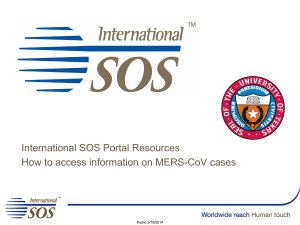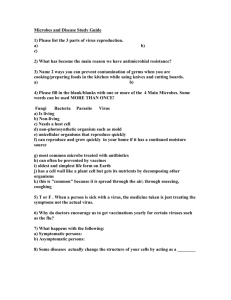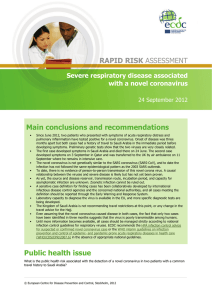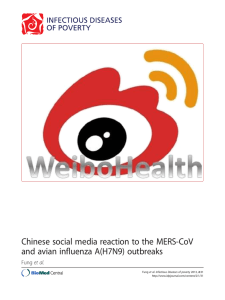From SARS to the Novel Coronavirus: Communicating Infectious
advertisement
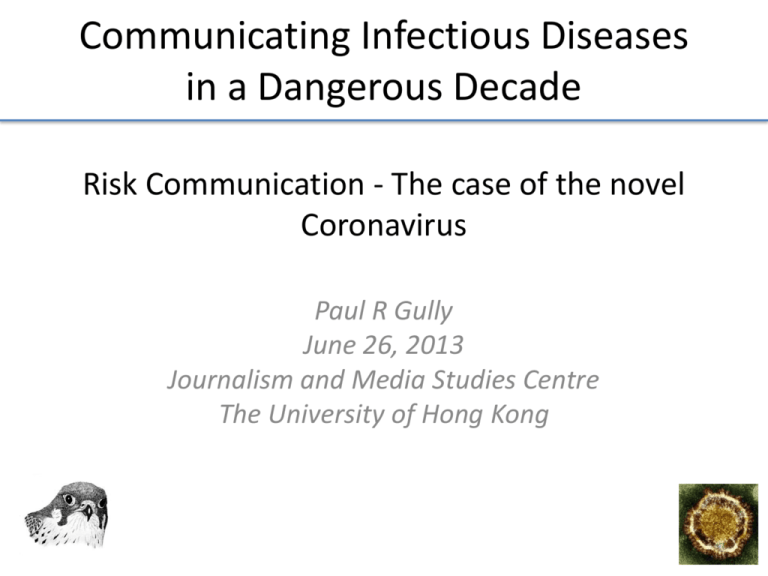
Communicating Infectious Diseases in a Dangerous Decade Risk Communication - The case of the novel Coronavirus Paul R Gully June 26, 2013 Journalism and Media Studies Centre The University of Hong Kong MERS-CoV • September 2012 to June 23, 2013 – WHO: 70 laboratory-confirmed cases including 39 deaths. – Cases originating in the Middle East • Jordan, Qatar, Saudi Arabia, and the United Arab Emirates (UAE), including limited local transmission • Imported cases: France, Germany, Italy, Tunisia, UK • Local transmission: France, Italy, Tunisia, UK – Epidemiology is as yet unknown RISK COMMUNICATION • Communication of information and analysis to those who will have to make decisions, in response to public health needs, for themselves and/ or others during an acute event. • Includes the public, politicians and front-line health care workers • What to communicate, to whom, how and when? WHAT HAVE WE LEARNED SINCE SARS? MERS-COV: A CASE STUDY IN RISK COMMUNICATION 1. 2. 3. 4. 5. Who are the various players talking to? Who is not talking and why? The role of ProMED The specific role of WHO and the IHR(2005). Who is talking to the general public, politicians and front-line health care workers? MERS-CoV: WHAT IS REPORTED AND TO WHOM? (1) • Government Agencies – e.g., PHAC, US CDC, HPA, ECDC (factual information on cases, risk of spread, guidance on preventing transmission) – Little analysis of the results of biomedical research, and the lack of epidemiologic data, except ECDC – High level to general public, politicians and sometimes health care workers • Science reporters e.g., Helen Branswell, Maryn Mckenna, Declan Butler, – Interviews with government/ international organizations and scientists – Little analysis of significance of research. – High level to niche audience of science watchers MERS-CoV: WHAT IS REPORTED AND TO WHOM? (2) • Laurie Garrett: – Analyses and overviews, credible and detailed but “the big one” bias – Niche audience • Bloggers: e.g. Fluwatch – Rumours, unconfirmed information – Useful “nudges” – Unclear as to audience • Scientists with a voice through the media: reporting of research with risk pronouncements – Unclear as to audience • Academic units: CIDRAP – Digests of information, some analysis – Scientists/ practitioners MERS-CoV: WHAT IS REPORTED AND TO WHOM? (3) • International Organizations: WHO, OiE – Factual reporting and advice to countries – High level to wide audience • World Health Assembly reports and tweets – High level policy issues: transparency, virus sharing – High level to wide audience • Bio-medical Journals – Peer reviewed articles – Science community WHO IS NOT TALKING AND WHY? • Kingdom of Saudi Arabia – Reporting cases to WHO as per IHR requirements but no reports on epidemiology despite much investigation and assistance from outside experts including WHO. – Report from last mission and WHO EMRO meetings – Waiting for definitive results (confirmed by Dr Ziad Memish – personal communication) – ? Concerns about further loss of control over virus – ? Concerns about risk of mass gatherings e.g., The Hajj – Loosing credibility when silence is perceived as a lack of transparency. Report of WHO mission, June 10, 2013 may assist in regaining trust. • Contrast with China and H7N9 THE ROLE OF PROMED • ProMED distributes moderated reports from scientists worldwide. – Considering the experience of Dr Zaki – Is the lack of communication from KSA as a result of the initial story and the perceived loss of control over the virus to the Erasmus Medical Centre? WHO AND THE IHR(2005). • WHO informed early by the KSA and other countries once the virus was identified and diagnostic tests developed – What information is WHO receiving as regards epidemiologic investigations which are not made public? THEMES • Public health reticence: where is the analysis of risk relevant to “host” country, analysis of issues such as perceived lack of transparency, and virus sharing • Scientists wish for attention: kudos and funding • WHO secretariat need to respect wishes of member states • Hesitance by some countries to be transparent • Void filled by science journalists WHO IS TALKING TO THE GENERAL PUBLIC ? • The general public and their representatives, politicians, and front-line health care workers hould be primed, in case we want them to act, to either protect themselves or to adhere to health protection policies. – Will these audiences listen before there is a crisis? – Will credibility be built up or maintained with more detailed, on going, widely distributed analyses? – Who will fulfill this role? WHAT DO WE NEED TO COMMUNICATE(1) • • • • Modes of transmission Likelihood of transmission Morbidity and mortality Actions to be taken to control risk with risk analysis, including infection control • Very challenging at present given lack of knowledge, SARS is being used as a proxy WHAT DO WE NEED TO COMMUNICATE(2) • Analyses of political/ policy issues – Virus sharing/ intellectual property – Lack of epidemiology • For H7N9 and perhaps MERS CoV – Effectiveness of anti-virals for treatment – Vaccine effectiveness and likely supply issues WHY COMMUNICATE • The success of public health action depends on cooperation of the public • Cooperation may be obtained if the immediate threat is great enough • Otherwise depends on trust that has been built up prior to an event • Trust can be easily lost through lack of transparency HEADLINES • “The coronavirus conundrum: when to press the panic button” The Guardian, Feb 14, 2013 – “We have become very good at detecting risk, but it's impossible to know if this latest virus will be another SARS or disappear” • “After SARS: A New Virus in Saudi Arabia Underscores the Need to Police Disease in Animals” Time. March 19, 2013 • Tweet Laurie Garrett • " Hard 2 explain contagion poten. w/out being HEADLINES • New coronavirus with “pandemic potential” sparks global surveillance efforts CMAJ April 4, 2013 – “A novel coronavirus (nCoV), with what one Canadian researcher calls a “very alarming” death rate, has triggered rapid research efforts to determine where it came from and where it may strike next. Two Canadian research teams are among those involved in the global response” HEADLINES • “Nature’s Bioterrorist Agents” Slate. April 10, 2013 • “From SARS to H7N9: will history repeat itself?” The Lancet. April 20, 2013 • “New Diseases and National Transparency: Who Is Measuring Up?” Wired. May 2, 2013 HEADLINES • “Transparency Unlocked: More New Saudi Coronavirus Cases Reported Quickly” Wired. May 4, 2013 • “Saudis bring in outside help on coronavirus, including Toronto SARS expert” CP. May 8, 2013 • “Even though work has been done since that time, the world is not ready for a large, severe outbreak” “This is an unusual global situation” Keiji Fukuda. May 22, 2013 • “The Politics of Virus Hunting” CBC. May 23, 2013 HEADLINES • “WHO: Scientific red tape mars efforts vs. virus” AP. May 23, 2013 • “MERS cases likely around globe, found in Saudi because country tests: official” CP. May 30, 2013 • “Administration declares Mideast flu a public health emergency” The Hill. June 4, 2013 • “Saudi paperwork demands delay work to research to find MERS source: CDC” CP June 7, 2013 SUMMARY • There has been a lot of coverage of MERS-CoV in the mainstream media, science media, and social media. • The messages are confusing • There has been low key communication from government agencies outside of affected countries. • There has been little analysis of the issues that the public is mostly likely to demand answers on if threatened. • Most media coverage has probably not been seen by the general public. CONCLUSION • There is an analysis and discussion gap, that needs to be filled so that the public, politicians and health care providers can understand the issues that appear as controversies in the media and trust in disease control organizations can be built and or maintained WHO HAS THE RESPONSIBILITY? • Proposal: – Objective is to build and maintain trust in disease control organizations and governments – Set up a group, virtual or otherwise, that • Analyses, day to day, science, media, official statements and opinions • Analyses and discusses controversial issues so that they can be understood by politicians and the general public • Recognizes the role of WHO, disease control organizations, departments of health, Governments and the media (science and popular) to provide facts and report on analyses of individuals, governments or agencies paulrgully@gmail.com
